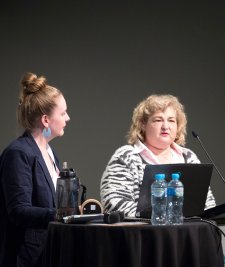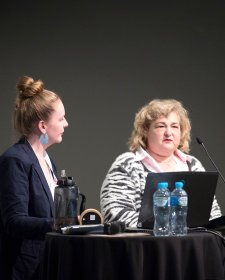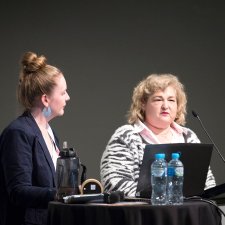1 in 5 Australians are people with disability – a large proportion of our society. Most people will experience some type of disability in their lifetime and many of us are also carers and support people for friends or family members with disability. We need to ensure that our attitudes are inclusive, our environments accessible, our workforces diverse and our processes user friendly so that everyone can benefit.
Our DIAP is a tool and resource to help guide us in our work with, by and for people with disability to ensure that everyone can engage with us and we can engage with everyone.
During our last DIAP, we worked with a talented group of staff and an external Disability Advisory Group to raise our awareness of issues and make key improvements to our space and practices. In this next DIAP, our focus is to build on this momentum and ensure access is built in from the beginning and embedded in the culture of the organisation. We want to aim beyond compliance and minimum standards to best practice and great user experience. This DIAP is about ensuring that access and inclusion is front of mind in everything we do. We are open and willing to change and adapt and there is a real desire from our people to be as accessible as possible.
This DIAP is about helping us move forward and strategy to guide us and make us accountable.
Alignment with our Strategy
Having a DIAP is a core part in enabling us to deliver on our purpose and functions as a publicly funded National Cultural Institution.
Diversity is a key principle reflected within our organisational vision:
‘The National Portrait Gallery aspires to reflect the face of Australia. It is the place where the national story unfolds with clarity, without complacency or self-satisfaction. The Gallery uses portraiture to tell Australian stories and to increase understanding and appreciation of Australian people – their identity, history, culture, creativity and diversity.’
Access and inclusion are also specifically represented as one of our four values:
We are inclusive and accessible
‘We are approachable, friendly and welcoming of our visitors and each other. We strive to ensure that the Gallery, the collection and our programs – both onsite and online – are accessible to all.’
This DIAP aligns with other key strategies and documents within the organisation, including the NPG Corporate Plan, NPG Operational Plan and the Reconciliation Action Plan.
Our vision for our DIAP
The Gallery celebrates inclusion and is committed to creating a welcoming environment for all – by removing or reducing social, economic, physical or behavioural barriers.
To realise our vision, over the next three years we strive to:
- build organisation-wide capability to increase disability confidence, eliminate discrimination and contribute to improving attitudes towards disability
- reflect contemporary society and promote the representation, recognition and participation of people with disability
- empower people with disability by continuing our improvements onsite and online to enhance access to information, facilities, programs, the collection and exhibitions
- make sustainable advancements in our professional practices by embedding access into our systems, strategies, planning and procedures to enable people with disability equal access to our programs and employment within our organisation.
Our DIAP principles
In accordance with our Corporate Plan 2022–23, the Gallery is committed to engaging with audiences and ensuring that accessibility and diversity informs all programming.
The Gallery is committed to the following accessibility principles:
- We regularly consult with and are informed by our Disability Advisory Group.
- We invite accessibility audits – these may cover physical access points, facilities and exhibition spaces from the perspective of an increasingly broad experience of disability.
- We explore innovative technologies to provide diverse access points to the collection, both onsite and in outreach programs to the community.
- For all our initiatives we strive for best practice and to comply with relevant standards and legislation.
- We eliminate discrimination and welcome staff with different experiences, cultural heritage and educational backgrounds, with employment conditions covered by the National Portrait Gallery Enterprise Agreement 2017–20 and the National Portrait Gallery of Australia Non-SES Employees Determination 2020–21.
- We are accountable and openly invite feedback and engagement with our community, are open to current ideas and actively implement changes.
With these principles we seek to promote social equity, acknowledge the exceptional contributions people with disability make, and encourage positive community attitudes.
Our DIAP goals
To do this, we have set ourselves the following goals to achieve over the next three years:
Goal 1: Attitudes and behaviours
We remove attitudinal barriers and encourage inclusive behaviours, enabling people with disability to engage and participate in Gallery activities through the reflection and continued training and revision of policy and practice.
Goal 2: Liveable communities
We strive to deliver an accessible physical and digital space to enable universal engagement.
Goal 3: Meaningful employment
We are committed to diversity and inclusion in our staff cohort, with people with disability having the opportunity to gain and retain employment within an accessible environment and an inclusive workplace culture.
Goal 4: Systems and processes
Our information, services and programs are built with accessible and inclusive systems and processes in mind, to ensure everyone can engage with them, with commitment to review and update giving people with disability choice and control.
In lieu of formal guidelines for Commonwealth entities, we have chosen to follow the NSW DIAP framework, which uses the four outcome areas listed above in our goals. Since its introduction in 2014, this framework has supported NSW entities to drive effective organisational change towards removing or reducing the social, economic, physical and behavioural barriers that prevent people with disability fully engaging with NSW public organisations.
Underneath these four areas, a range of strategies and actions have been developed which the Gallery will deliver over the next three years. These will enable people with disability to have greater access to Gallery information, services, programs, events and facilities.
















